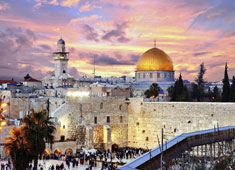THE-RITES-OF-Umrah
Umrah
Umrah (the minor pilgrimage) etymologically is derived from " Al Îtimar " which means "a visit". The one who wants to perform Umrah, enters a state of Ihram since the Meeqat, perform Tawaf (circumbulation) of the Umrah, perform the Sâayi between Safa and Marwa and finally the pilgrim puts off his Ihram by cutting or shaving his hair.. | |
| The Meeqaat is the place from where the pilgrims change their clothes and wear the garments of Ihram . The Meeqats are the known, unlimited precise places for those intending to perform Umrah when they are on their way to the sacred house ; it is in these places that pilgrims must be in a state of sacralization before starting the performance of the rituals : These Meeqaats are:
|
| The best type of Hajj is the Tamattu, thanks to it we shall combine the Umrah and the Hajj and perform them at the same time . Namely, when we begin by the performance of Umrah , being on a state of Ihram and then during the 8th day of Dhu Al-Hijjah, we dress on Ihram clothing and we perform Hajj. In itself , an Umrah can be performed in a time of 2 till 3 hours . Meanwhile, when the Pilgrim takes his Ihram in Abâr 'Aly (Dhoû-l-Houlayfa) 12 kilometres away from Medina, he/she must count about one day to this first Umrah (he/she can depart in the middle of the morning and finish the rituals of his/her Umrah by the end of the evening according to his/her own rythm ). |  |
| below you will find the itereranry stages of Umrah performance : | |
 | |
| 1-Ihram (circumbulation)An Umrah begins by entering into the state of Ihram, even before entering the sacred city. | |
 | First of all, for men it is advisable to shave his hair, to cut his nails, to get rid of his pubes hair, to take a bath ( Ghusl), then, to wear two pieces of fabric called the Izaar and the Ridaa, clean and preferably new , to perfume his head and beard but not his Ihram garments. this clothing concerns only men. No other clothing is allowed to be worn in addition to these – no underwear, no pants, no shirt, no turban, no hat, etc. are to be worn. There is no specific clothing designated for women, except that they are prohibited from wearing the Niqaab (face-veil) and gloves. However, they may cover their hands with the lower part of their khimaar (head covering), while using the upper part of their jilbaab (outer garment) or a separate piece of fabric to cover their faces by drawing it down, if there is need to do so.. |
The two rak’ahs of Ihram are not obligatory, Though, if we are in a mosque, we can always pray.
| |
| 2- Tawaf (Circumblation) | |
 | When reaching the black stone , we say« Bismil-laahi Allaahu Akbar » and we start by these invocations : « Oh God, with your Faith, Faith in your holy Book, an Faith in your Promises, and the obedience to your Prophet. » There are no specific invocations to be recited in each round, so do not give great importance to the libraries which sell prayer books special to Tawaf, of course they are certainly helpful but they should not restrict your prayers . The pilgrim can make invocations, read verses of the holy Coran, etc. - For man, it is advisable to walk rapidly among small groups and to show off his right shoulder during Tawaf. When reaching the corner of the black stone we should say these invocations : |
| 3- Go to Zemzem | |
 | After the Tawaf,the pilgrim approaches Maqaam Ibraaheem (Ibraaheem’s station). Then prays two short Rak’ahs. Because there are many pilgrims, We can pray far from Maqaam Ibraaheem to avoid congestion meanwhile to enjoy a calm atmosphere. If this is possible, we can go to Multazam to relax and pray . There is a profoundly saint place that lies between the black stone and the door of the Kâaba,of about two metres length , where we can pray . If you succeed to reach this place , pray to allah so that he, the almighty, accords you his mercy . If, beacause if the huge number you cannot reach the Multazam, simpley turn to this place and pray. |
 | Then we go to the Zemzem fountain to drink as much as we can , to get ourselves ready for a long and exhaustive trip . |
| 4- Making sa’i between safa and marwa | |
 | - We climb unto mount Safaa until the Ka'bah is visible, We are facing the Qibla, we raise hands mains and say « Allaahu Akbar » (Allaah is the Greatest). - Then we can ask God whatever we want through invocations (Douâa) ; - Then we descend and go towards Marwah. There are two green bannsers to indicate that we have to run when we are walking. Repeat the same procedure as when ascending the Safaa mount. |
| 5- Shaving or cutting the hair | |
Once sa’i is accomplised, men can shave or cut their hair . Women should cut one or two centimetres of their head hair too. (For man, if they want to immediately accomplish Hajj after the Umra, they could not shave their head hair, but simply cut and shorten it). Click Here to read the Hajj and Umrah latest news. |













 TUNIS
TUNIS Casablanca
Casablanca ALGER
ALGER





 Algeria
Algeria France
France Morocco
Morocco Saudi Arabia
Saudi Arabia Tunisia
Tunisia